A FORWARD ENERGY GROUP MULTICLIENT
STUDY
Description
of the Gas Supply Trends Study 1990-2008 in pdf format
Natural Gas
Supply Trends in Western Canada 1990-2008 provides independent,
current and detailed analysis by industry experts on the trends, sources and
operators of new gas supply in Western Canada.
Sustaining and growing production at competitive costs
poses a challenge for operators in Western Canada. The initial rate per
new well has been decreasing and initial decline rates have been
increasing. Western Canada remains a critical supply basin for North
America. In 2007
the basin produced gas at over 16.5
Bcf/d, supplying
almost 25% of Canadian and US demand. However, over 3.7
Bcf/d of new
productive capacity must be added each year to replace natural
decline.
From 1990 to
2005, increasing natural gas prices expanded the set of profitable
opportunities in the WCSB. However, recent increases in capital costs,
lower natural gas prices, less favourable exchange rates and increased
competition for capital from US shale gas plays now provide challenges for
operators to add new gas supply in the WCSB. Over 157,000 gas wells
connected between 1990 and 2007 record the industry response, both to the
new opportunities and to the current challenges Natural Gas Supply
Trends in Western Canada provides operators the tool to
review their investments in Western Canadian gas and to evaluate the
strategic alternatives available in this large, diverse and active basin.
back to top
To
examine industry’s response to this supply challenge, Forward Energy Group
has updated the data
base with results to
year-end 2007.
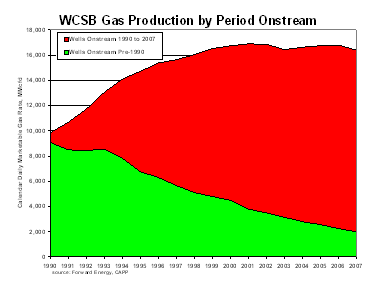 Natural Gas Supply Trends
in Western Canada
provides the comprehensive and consistent information
required to evaluate strategic alternatives. Understanding recent trends
is invaluable for operators evaluating their current and proposed
strategies, highlighting potential plays to enter and identifying
operators with strategic positions. Are these firms your competitors,
partners, acquisition targets or role models? For the service sector,
midstream processors, gas marketers and investment analysts, this study
identifies and characterizes the gas producers in your target market. Natural Gas Supply Trends
in Western Canada
provides the comprehensive and consistent information
required to evaluate strategic alternatives. Understanding recent trends
is invaluable for operators evaluating their current and proposed
strategies, highlighting potential plays to enter and identifying
operators with strategic positions. Are these firms your competitors,
partners, acquisition targets or role models? For the service sector,
midstream processors, gas marketers and investment analysts, this study
identifies and characterizes the gas producers in your target market.
back to top
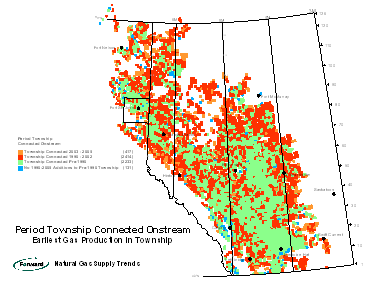
Natural Gas
Supply Trends
examines the following key issues that affect corporate
strategies:
 |
Discover, Develop or Accelerate?
— How much of the recent production additions came from newly-discovered
pools? What “old” pools are major sources of new production? Is
exploration a viable strategy for a basin this mature? |
 |
Plays
that Deliver
— High flow rates per well make headlines but are the Foothills and deep
Devonian plays the future of gas supply? What alternatives are there to
high risk/high reward plays? How significant is the supply added by
low-deliverability wells in resource plays? |
 |
Decline
Dilemma
— High decline rates drive many operators on the production replacement
treadmill. Which plays are chronic high decliners? What zones and
areas appear to have lower decline rates? |
 |
Unconventional Gas
— What are
the impacts of recent developments in coalbed methane,
shale gas and tight gas? |
 |
Geographic Distribution
—Where is production and reserves growth occurring? What areas of the
basin are newly-connected? How important are new areas to gas supply?
What areas of the basin remain non-productive? |
 |
Top
Operators
— Which operators are most successful at adding production from
internally-generated opportunities? Which operators are accelerating
production growth? What portion of currently-operated production did
operators acquire? Do effective operators use common strategies in
their play portfolios? Are they focused or diversified? |
 |
Technology
— What has been the impact of horizontal drilling on natural gas
production growth and decline rates? Has fracture stimulation developed
increased supply from unconventional tight gas sources? |
 |
Cycle Time
— How efficient is industry at connecting newly drilled gas wells? Which
operators, and in which areas, are the quickest at their gas connections?
|
 |
Multi-zone Supply
— Does stacked multi-zone potential result in higher recovery and
production per well? How significant is new production from
recompletions in old wellbores? |
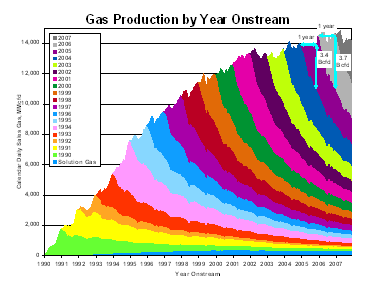
back to top
Forward
Energy applies proprietary methods to select and integrate well data,
historical production and pool reserves information.
Important benefits from data integration include analysis by pool
discovery year and average depth and conversion of volumes from raw to
marketable. The production profile for each well is fitted with a decline
function to characterize its supply contribution and producing
characteristics.
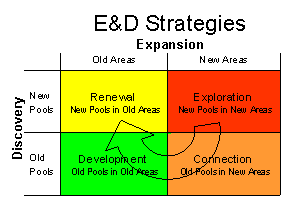 Wells
are classified into groups according to zone depth, pool discovery period,
stratigraphic group and eight other dimensions. The Exploration and
Development Strategy model, described in SPE paper no. 82027, is just one
example of Forward Energy’s innovative approach to understanding industry
strategies for adding production. Wells
are classified into groups according to zone depth, pool discovery period,
stratigraphic group and eight other dimensions. The Exploration and
Development Strategy model, described in SPE paper no. 82027, is just one
example of Forward Energy’s innovative approach to understanding industry
strategies for adding production.
The
contributions of supply sources are summarized and analyzed for
characteristics and trends. Colour charts illustrate the trends
identified. A unique feature of this study is the extensive use of
colour-coded maps to display the geographic distribution of new supply.
Operator
analysis includes a review of supply characteristics, rate addition
patterns, geographic distribution, portfolio analysis and A&D strategies
for major and emerging operators. To analyze the impact of strategic
corporate acquisition by operator, supply additions from predecessor
operators are included with their corporate successors.
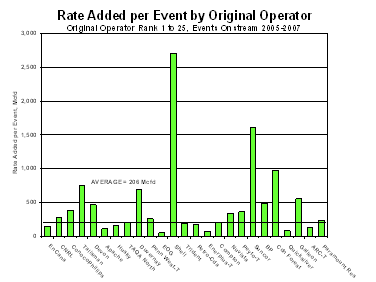
Methods
applied at each step ensure the quality, reliability and integrity of the
database and analytical results. The study database is an ongoing
resource available to subscribers to answer questions with ad-hoc
queries. Natural Gas Supply Trends features unprecedented
and leading edge analysis not available elsewhere.
back to top
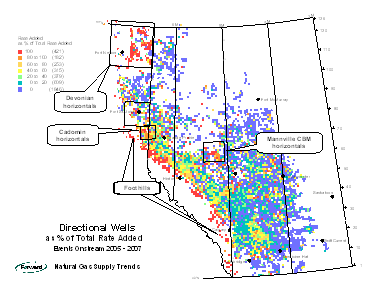
Overview and
Methodology
Gas Supply
Trends
Graphs, maps
and text describing trends and patterns in the measure of gas supply:
connection activity, rate additions, extrapolated ultimate recovery (EUR),
average annual decline rate and discounted production.
Sources of
Supply
Graphs, maps and
text describing trends and patterns supply by:
 |
Exploration and Development Strategies |
|
 |
Pool Discovery Period |
|
 |
Completion Type |
|
 |
Geographic Region |
|
 |
Cycle Time |
|
 |
Stratigraphic
Group |
|
 |
Well Orientation |
|
 |
Zone Depth Class |
|
 |
Fracture Stimulation |
|
 |
Well Deliverability Class |
|
 |
Coalbed
Methane |
|
Operator Analysis
 |
Original
Operators — combines the results of predecessor firms with their
successors |
 |
Rate
addition trend plot and rate-added maps for each operator |
 |
Operator
portfolio comparisons by supply sources
|
 |
Acquisition and divestiture strategies |
back to top
Applications
Make better
decisions about future investments grounded on current trends and recent
patterns:
 |
Identify,
quantify and visualize emerging gas supply trends |
 |
Define and
validate corporate gas strategies in the WCSB
|
 |
Replace
myths with objective analysis of operator strategies and performance |
 |
Evaluate
internal and acquisition opportunities with an independent source for
due diligence |
 |
Select and
prioritize opportunities for further technical evaluation from a
basin-scale overview down to the township and well level |
 |
Communicate
your strategies with our maps, charts and analysis in your corporate
presentations |
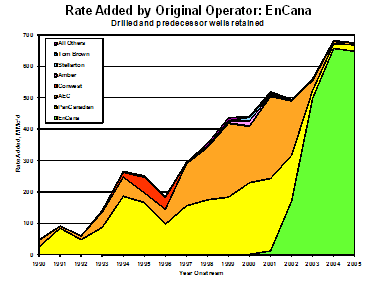
back to top
 |
Update Summary:
presentation summarizing selected summary topics |
 |
Workshop: to
apply study to specific client needs; topics developed with client |
 |
Access to study
database for custom queries |
 |
Historical
reports and updates that include: over 100 full page colour maps with
spatial trends of gas supply additions; over 250 colour figures illustrating
supply trends, sources of supply and operator portfolios; text describing
the methodology, providing the interpretation and highlighting the
implications |
Additional Services
 |
·
Customized
analysis: peer comparisons, detailed regional analyses, database queries,
benchmarking, etc. |
Interested?
Dave Flint
(403) 261-1018
Bob Dixon (403) 261-1019
E-mail:
dwflint@forwardenergy.ca
rkdixon@forwardenergy.ca
back to top
Description of the Gas Supply Trends Study in pdf format
|

